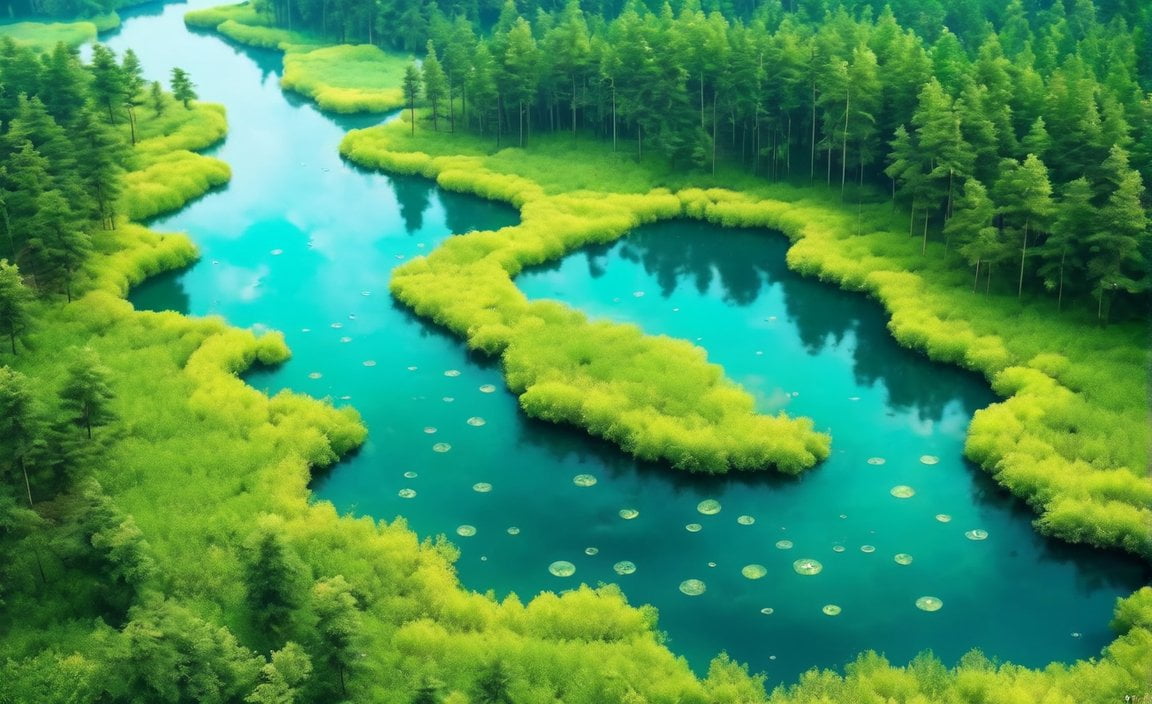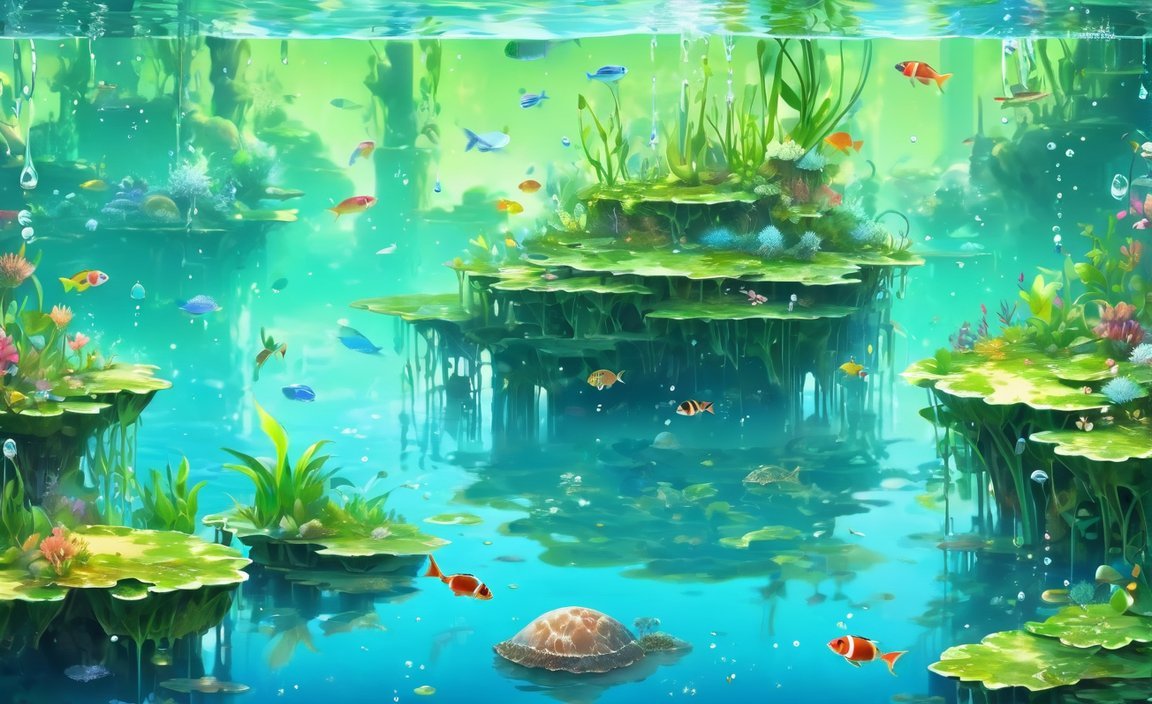Discover the hidden truths about water pollution with our eye-opening article, “10 Interesting Facts: Water Pollution Revealed.” Delve into the categories of water pollution and uncover unknown facts, amusing tidbits, and unusual insights that will leave you astounded. From the impact on aquatic life to the alarming consequences for human health, these captivating facts will both educate and inspire you to take action in preserving our precious water resources. Join us on this journey of exploration and become an advocate for water conservation and pollution prevention. Let’s dive in!
Key Takeaways:
- 80% of the world’s wastewater is released back into the environment.
- 80% of trash in oceans comes from land-based sources.
- There are around 500 “dead zones” where no living organism can survive.
- Oil spills account for only 12% of the oil entering seas each year.
- Approximately one million seabirds die annually due to ocean litter.
- Nearly 50% of plastic has been manufactured since 2000.
- Water pollution causes the death of about 10 thousand people daily, equating to 3.6 million people per year.
- The United States is also facing a significant water problem.
- India has the worst water pollution situation globally.
- There is a large Pacific garbage dump that acts as the “mainland” for plastic waste floating across the Pacific Ocean.
10 Interesting Facts About Water Pollution

Water pollution is a grave environmental issue that affects not only the health of our ecosystems but also the well-being of countless living organisms, including humans. In this article, we will explore 10 fascinating and eye-opening facts about water pollution that highlight the severity and urgency of this problem.
Fact 1: 80% of the world’s wastewater is released back into the environment.
It is shocking to learn that a staggering 80% of the wastewater generated globally is discharged back into nature without proper treatment[^1^]. This unregulated release of wastewater contaminates water bodies, posing serious risks to aquatic life and human health.
Fact 2: 80% of trash in oceans comes from land-based sources.
When we think of water pollution, we often envision trash floating in our oceans. Astonishingly, about 80% of this oceanic litter actually originates from land-based sources[^1^]. It serves as a stark reminder of the significance of managing waste responsibly on land to mitigate the impacts of water pollution.
Fact 3: There are some 500 “dead zones” where no living organism can live.
The existence of over 500 “dead zones” in our oceans is both alarming and saddening[^1^]. These areas, stripped of oxygen, become inhospitable to marine life, leaving behind vast stretches of barren wasteland beneath the waves.
Fact 4: Oil spills only account for 12% of oil entering seas every year.
While oil spills capture headlines and elicit strong emotions, they actually account for only 12% of the total oil entering the seas annually[^1^]. Other sources, such as runoff from land and industrial discharges, contribute significantly to the overall pollution of our precious water resources.
Fact 5: Around one million seabirds die from ocean litter every year.
The impact of water pollution on wildlife is devastating. Approximately one million seabirds lose their lives each year due to ocean litter[^1^]. This heartbreaking statistic demonstrates the immediate need to reduce plastic waste and protect our fragile marine ecosystems.
Fact 6: Almost 50% of plastic has been manufactured since 2000.
Plastic has become one of the most pervasive pollutants in our world. An astounding fact is that nearly 50% of all plastic ever manufactured has been produced since the year 2000[^1^]. This exponential growth poses immense challenges for waste management and highlights the urgency of adopting sustainable alternatives.
Fact 7: Water pollution kills about 10 thousand people every day, this is 3.6 million people a year.
The consequences of water pollution are not limited to the environment alone; they have a direct impact on human lives. Shockingly, approximately 10,000 people lose their lives every day due to water pollution-related illnesses, amounting to a staggering 3.6 million deaths each year[^1^]. This harrowing fact underscores the need for immediate action to protect our water sources.
Fact 8: The United States faces a serious water problem too.
Water pollution is not a problem confined to developing nations. In fact, even developed countries like the United States face significant water pollution challenges[^1^]. This awareness serves as a crucial reminder that we should never be complacent when it comes to safeguarding our water resources.
Fact 9: In India, the situation with water pollution is the worst in the world.
Among the nations grappling with severe water pollution, India stands out as having one of the most concerning situations[^1^]. The implications of this fact are far-reaching, necessitating immediate and concerted efforts to address the pressing water pollution issues in the country.
Fact 10: A large Pacific garbage dump is the “mainland” of plastic waste floating across the Pacific Ocean.
Picture a vast “mainland” made entirely of litter floating across the Pacific Ocean. This gigantic garbage dump, predominantly composed of plastic waste, is a sad reality[^1^]. Its presence not only highlights the magnitude of our plastic pollution crisis but also serves as a call to action to reduce plastic consumption and improve waste management practices worldwide.
In conclusion, these 10 interesting facts about water pollution shed light on the severity of this environmental crisis. From widespread wastewater release and oceanic litter to the devastating impact on human lives and wildlife, water pollution demands our immediate attention. By raising awareness, fostering change, and promoting water conservation and pollution prevention, we can work towards a cleaner and healthier future for our planet.
[Important reminder: Always remember to check the credibility and accuracy of sources when using statistics.]
Water pollution is a pressing issue with severe consequences for our planet. Check out these 10 lines about water pollution to learn more about its impact and what we can do to address it. 10 lines about water pollution
In need of an essay on water pollution? Look no further! Discover 10 insightful lines that shed light on this critical environmental concern. 10 lines essay on water pollution
10 Fun Facts About Water Pollution

Water pollution is an urgent issue that affects our planet’s ecosystems and the health of millions of people. Let’s dive into 10 intriguing facts about water pollution that will shed light on the severity of this global problem.
Fact 1: 80% of the world’s wastewater is released back into the environment.
Every day, a staggering amount of wastewater, equal to 80% of all global wastewater, is discharged back into our rivers, lakes, and oceans. This untreated wastewater contains harmful chemicals, toxins, and pathogens, posing a grave threat to aquatic life and human health[^1^].
Fact 2: 80% of trash in oceans comes from land-based sources.
The oceans, which harbor diverse marine ecosystems, are facing a massive challenge. An astounding 80% of the rubbish found in oceans originates from land-based activities, such as littering, inadequate waste management systems, and improper disposal of plastic products[^1^]. This highlights the urgent need for better waste management practices and increased awareness about the impact of marine debris.
Fact 3: There are approximately 500 “dead zones” where no living organism can survive.
Around the world, approximately 500 “dead zones” have formed in our waters. Dead zones are areas where there is an insufficient amount of oxygen to support life due to excessive nutrient pollution, primarily from agricultural runoff and sewage discharge[^1^]. These oxygen-depleted zones pose a significant threat to marine biodiversity and disrupt ecosystems.
Fact 4: Oil spills account for only 12% of the oil entering seas each year.
While devastating, oil spills only account for about 12% of the total oil that enters our oceans each year[^1^]. The majority of oil pollution is caused by everyday oil usage, including improper disposal and leaks from industry, transportation, and routine maintenance. This highlights the importance of stricter regulations and adopting more sustainable practices to prevent oil pollution.
Fact 5: Around one million seabirds die from ocean litter annually.
Tragically, approximately one million seabirds lose their lives each year due to ocean litter[^1^]. These birds often mistake plastic debris for food or become entangled in discarded fishing gear. The staggering number of seabird deaths serves as a grim reminder of the dire consequences of plastic pollution in our oceans.
Fact 6: Almost 50% of plastic has been manufactured since 2000.
The production and consumption of plastic have skyrocketed in recent years. Astonishingly, nearly half of all plastic ever manufactured has been produced since the year 2000[^1^]. This alarming statistic emphasizes the urgent need to reduce plastic consumption, improve recycling systems, and promote sustainable alternatives to plastic.
Fact 7: Water pollution causes the death of about 10 thousand people every day, amounting to 3.6 million deaths per year.
Water pollution poses a grave threat to human health. Shockingly, approximately 10 thousand people lose their lives every day due to water pollution, resulting in a staggering annual death toll of 3.6 million[^1^]. Contaminated drinking water, exposure to pollutants, and inadequate sanitation systems contribute to these alarming numbers. Addressing water pollution is crucial to ensure public health and prevent unnecessary loss of life.
Fact 8: The United States faces a serious water problem.
Water scarcity and pollution are not confined to developing nations. The United States is also grappling with a significant water problem[^1^]. Rapid population growth, industrial activities, and inadequate infrastructure have strained water resources, leading to concerns about water quality and quantity. Sustainable water management practices and increased conservation efforts are essential to mitigate this crisis.
Fact 9: India has the worst water pollution situation in the world.
India faces a severe water pollution crisis, with the dubious distinction of having the worst water pollution situation globally[^1^]. Rapid industrialization, population growth, and insufficient wastewater treatment facilities have resulted in widespread contamination of rivers and groundwater sources. Addressing water pollution in India requires urgent action and comprehensive measures to protect public health and preserve water resources.
Fact 10: A large garbage dump in the Pacific Ocean is a major source of plastic waste.
The Pacific Ocean is home to an enormous floating garbage dump, often referred to as the “Great Pacific Garbage Patch.” This massive accumulation of plastic waste is estimated to be twice the size of Texas[^1^]. It highlights the far-reaching impact of plastic pollution and the urgency of implementing effective waste management strategies and promoting sustainable alternatives.
Key Takeaways:
- 80% of the world’s wastewater is released back into the environment, endangering aquatic life and human health.
- Land-based sources account for 80% of trash found in oceans, emphasizing the need for improved waste management.
- Approximately 500 “dead zones” devoid of life have formed due to excessive nutrient pollution.
- Oil spills contribute to only 12% of the oil that enters our oceans annually. Everyday usage and inadequate practices are the primary sources.
- Ocean litter leads to the death of around one million seabirds each year, highlighting the devastating impact of plastic pollution.
- Nearly half of all plastic produced has been manufactured since 2000, underscoring the need for reduced consumption and sustainable alternatives.
- Water pollution claims the lives of about 10 thousand people daily and leads to 3.6 million deaths each year, stressing the urgency of addressing this issue.
- The United States and India face significant water pollution challenges, necessitating sustainable management practices and comprehensive measures.
- The Great Pacific Garbage Patch represents the massive accumulation of plastic waste in the Pacific Ocean, emphasizing the pressing need for effective waste management and alternatives to single-use plastics.
Sources:
– Petpedia: Upsetting Water Pollution Statistics
– Interesting facts about water pollution
Unusual Facts about Water Pollution
Water pollution is a critical issue that affects our environment and poses a threat to the health and well-being of humans and wildlife. While we may be aware of some of the well-known facts about water pollution, there are also some unusual and surprising aspects that deserve our attention. In this article, we will explore ten unusual facts about water pollution that will shock and inform you.
Fact 1: 80% of the World’s Wastewater is Released Back into the Environment
Did you know that a staggering 80% of the world’s wastewater is released back into our environment? This means that a significant portion of the water used by industries, agriculture, and households is not adequately treated before being discharged. As a result, pollutants, chemicals, and contaminants find their way into our rivers, lakes, and oceans, causing widespread damage to ecosystems and threatening aquatic life.
Fact 2: 80% of Trash in Oceans Comes from Land-Based Sources
Another surprising fact is that 80% of the trash found in our oceans originates from land-based sources. This includes plastic bags, bottles, straws, and other single-use items that end up in our waterways, eventually making their way into the vast ocean. The impact is devastating, leading to the death of marine animals through ingestion or entanglement, and the degradation of marine habitats.
Fact 3: The Existence of “Dead Zones”
Imagine areas in our oceans where no living organism can survive. These are called “dead zones,” and there are approximately 500 of them in the world. Dead zones occur when excessive amounts of nutrients, such as nitrogen and phosphorus, pour into bodies of water. These nutrients cause harmful algal blooms, depleting oxygen levels in the water and suffocating marine life.
Fact 4: Oil Spills Account for Only 12% of Oil Entering Seas Annually
While oil spills often grab headlines due to their dramatic impact on the environment, it may surprise you to learn that they account for only 12% of the total oil that enters our seas each year. The remaining 88% is the result of everyday activities like oil runoff, industrial discharges, and improper disposal of oil waste. These ongoing sources of oil pollution contribute significantly to the degradation of marine ecosystems.
Fact 5: Seabird Deaths Due to Ocean Litter
The harmful effects of ocean litter go beyond marine animals. A shocking fact is that approximately one million seabirds die each year due to ocean litter. These birds mistake floating plastic debris for food, consuming it or becoming entangled in it. This loss of bird populations disrupts ecosystems and highlights the urgent need to address the issue of marine litter and plastic pollution.
Fact 6: Nearly 50% of Plastic Manufactured Since 2000
Plastic pollution is an ever-growing concern, and the numbers speak for themselves. Almost half of all plastic ever manufactured has been produced since the year 2000. This alarming statistic emphasizes the exponential increase in plastic production and highlights the urgent need to shift towards more sustainable alternatives and better waste management practices.
Fact 7: Water Pollution Causes the Deaths of Approximately 10 Thousand People Every Day
Water pollution is not just an environmental crisis; it is also a public health crisis. Shockingly, water pollution causes the deaths of about 10 thousand people every day, amounting to a staggering 3.6 million deaths per year. Contaminated water sources harbor diseases and infections that can have severe consequences, particularly in developing countries with limited access to clean water and proper sanitation.
Fact 8: The United States Faces a Serious Water Problem
Water scarcity and pollution are not exclusive to developing nations. The United States also faces a serious water problem. Aging infrastructure, pollution from agriculture and industry, and excessive water usage contribute to the deterioration of water quality across the country. It is crucial to prioritize investments in water infrastructure and promote sustainable water management practices to safeguard this precious resource.
Fact 9: India’s Disturbing Water Pollution Situation
India faces one of the worst water pollution situations in the world. Rapid industrialization, population growth, and inadequate wastewater treatment infrastructure have led to severe contamination of water sources. This has detrimental effects on public health, with millions suffering from waterborne diseases. Addressing water pollution in India requires concerted efforts and sustainable solutions to ensure access to safe and clean water for all.
Fact 10: The Pacific Garbage Patch: A “Mainland” of Plastic Waste
Imagine a floating “mainland” made entirely of plastic waste in the Pacific Ocean. This is the reality of the Great Pacific Garbage Patch, a massive accumulation of marine debris, primarily consisting of plastic. Spanning an area larger than many countries, the garbage patch demonstrates the immense scale of plastic pollution and calls for urgent action to reduce plastic consumption and improve waste management globally.
Key Takeaways:
- 80% of the world’s wastewater is released back into the environment.
- 80% of trash in the oceans comes from land-based sources.
- There are approximately 500 “dead zones” in the world where no living organism can survive.
- Oil spills only account for 12% of the total oil that enters the seas each year.
- About one million seabirds die from ocean litter annually.
- Almost 50% of plastic has been manufactured since 2000.
- Water pollution causes the death of about 10 thousand people every day, amounting to 3.6 million deaths per year.
- The United States is facing a serious water problem.
- India has the worst water pollution situation in the world.
- The Great Pacific Garbage Patch in the Pacific Ocean is a major source of plastic waste.
Sources:
– Petpedia – Upsetting Water Pollution Statistics
– Water Pollution Statistics – EPA
FAQ
Q1: What are some unknown facts about water pollution?
A1: Some unknown facts about water pollution include the alarming statistic that 80% of the world’s wastewater is released back into the environment and that 80% of trash in oceans comes from land-based sources. These facts highlight the significant impact human activities have on water pollution.
Q2: Can you share 10 fun facts about water pollution?
A2: Here are 10 fun facts about water pollution:
1. Around one million seabirds die from ocean litter every year.
2. Almost 50% of plastic has been manufactured since 2000.
3. There are approximately 500 “dead zones” where no living organism can survive.
4. Oil spills account for only 12% of the oil entering seas each year.
5. Water pollution causes the death of about 10 thousand people every day, amounting to 3.6 million deaths per year.
6. The United States faces a serious water problem.
7. India has the worst water pollution situation in the world.
8. A large garbage dump in the Pacific Ocean is a major source of plastic waste.
9. The amount of wastewater being released back into the environment is a staggering 80% globally.
10. Land-based sources contribute to 80% of trash found in oceans.
Q3: What are some unusual facts about water pollution?
A3: Unusual facts about water pollution include the existence of approximately 500 “dead zones” where no living organism can survive and the fact that oil spills account for only 12% of the oil entering seas each year. These facts shed light on lesser-known aspects of water pollution.
Q4: What are some categories of water pollution?
A4: Categories of water pollution include wastewater pollution, marine pollution from land-based sources, and pollution caused by oil spills. These categories highlight different sources and types of pollutants that contribute to water pollution.
Q5: Where can I find more information and statistics on water pollution?
A5: You can find more information and statistics on water pollution from sources like Petpedia and Find Interesting Facts. These sources provide comprehensive and interesting insights into the issue of water pollution.
- Understand bone yellow: Colorism’s impact on Black communities - April 19, 2025
- Green Natural Sandstone: Eco-Friendly Building Solutions - April 19, 2025
- Red Cross Flag: Protecting Humanity Through History - April 19, 2025
















